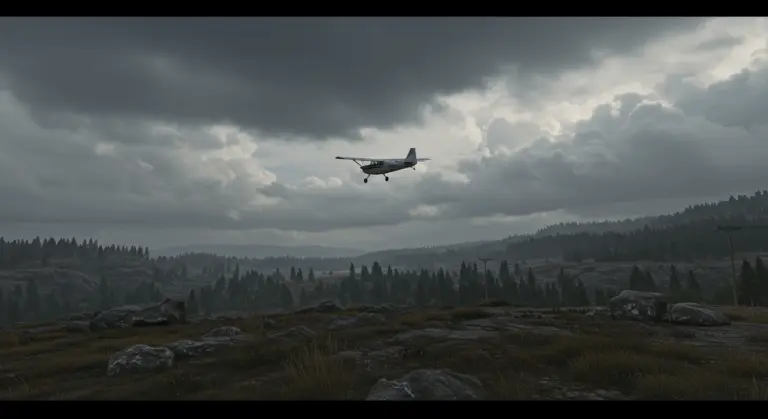VFR Fuel Requirements – Understanding Legal Standards
Overview of VFR Fuel Requirements
Visual Flight Rules (VFR) operations demand specific fuel requirements that serve as essential safety foundations. These regulations—varying by aircraft type and operational timeframe—ensure pilots carry sufficient fuel to reach their destination while maintaining essential reserves for unforeseen circumstances.
VFR fuel requirements establish clear thresholds: pilots must carry sufficient fuel to reach their first intended landing point while maintaining specific reserves at normal cruise speed:
-
Airplanes (Day): 30 minutes
-
Airplanes (Night): 45 minutes
-
Helicopters (Day/Night): 20 minutes
These constitute binding legal obligations, not mere suggestions under 14 CFR § 91.151. The regulation demands pilots factor in wind patterns and forecast weather conditions, ensuring adequate fuel reserves for contingencies such as route deviations or rapidly deteriorating conditions.
Daytime VFR Fuel Requirements
Under 14 CFR § 91.151, daytime VFR flights in airplanes must carry sufficient fuel to reach their first destination plus maintain a 30-minute reserve at normal cruising speed.
This 30-minute reserve represents the absolute legal minimum and must incorporate wind and weather variables. Pilots calculate fuel burn using aircraft performance data, then adjust for factors like persistent headwinds that significantly increase consumption rates.
This requirement provides a vital safety buffer against unexpected delays or diversions. While 30 minutes marks the regulatory floor, experienced pilots often carry much larger reserves—particularly when mentoring new aviators or navigating regions with sparse landing alternatives.
Impact of Weather on Daytime Fuel Planning
Weather represents the most critical variable in VFR fuel planning. Pilots must meticulously evaluate both current conditions and forecast trends that directly impact fuel consumption patterns.
Strong headwinds pose the primary concern, reducing ground speed and extending flight duration. For example: a 20-knot headwind against an aircraft cruising at 120 knots increases fuel consumption by roughly 20% to cover identical distances.
Turbulence increases fuel burn as engines work harder to maintain consistent speed and altitude. Climbing to escape turbulent air consumes additional fuel reserves.
Air density variations—influenced by temperature and humidity—also affect engine performance and fuel efficiency. Hot, humid conditions can reduce operational efficiency while increasing consumption rates.
Nighttime VFR Fuel Requirements
Nighttime VFR operations impose stricter fuel requirements due to amplified operational risks. Under 14 CFR § 91.151, airplanes must carry sufficient fuel to reach their first destination plus maintain a 45-minute reserve at normal cruising speed.
This 45-minute reserve—extending 15 minutes beyond daytime requirements—creates additional safety margins for night operation’s unique challenges.
Safety Considerations for Nighttime Flights
Key safety challenges influencing night fuel planning include:
-
Visibility Limitations: Reduced depth perception makes it harder to identify terrain, obstacles, and emergency landing sites, potentially requiring fuel-consuming diversions.
-
Airport Availability: Fewer airports are open or have runway lighting after sunset, increasing the distance to a suitable alternate.
-
Pilot Fatigue: Natural performance decline at night can affect decision-making, making a larger fuel buffer a critical safety tool.
-
Difficult Weather Assessment: It is harder to visually detect clouds, fog, and precipitation at night, which may force unexpected and fuel-intensive route changes.
Therefore, careful pilots establish personal minimums exceeding the 45-minute regulation. Many adopt standards like landing with at least one hour of fuel remaining, providing strong buffers against these inherent nighttime risks.
Helicopter VFR Fuel Requirements
Helicopters operate under distinct VFR fuel requirements. According to 14 CFR § 91.151, rotorcraft pilots must plan to land with at least a 20-minute fuel reserve at normal cruising speed.
This 20-minute reserve applies uniformly to both day and night operations—unlike airplane regulations. The standard reflects rotorcraft’s unique operational advantages, particularly their ability to execute landings in confined or improvised areas.
Calculations must still incorporate wind and weather factors. Accurate wind assessment becomes crucial since helicopters’ typically lower cruising speeds make them especially vulnerable to headwind impacts.
While 20 minutes represents the legal minimum, many commercial operators—including medical transport and search-and-rescue services—mandate substantially higher reserves. Mission-critical operations and potential extended hovering requirements drive these conservative standards.
Pilots must recognize that fuel consumption increases dramatically during hovering operations, high-density altitude conditions, or when carrying heavy payloads. These factors make conservative planning critical.
Regulatory Framework for VFR Fuel Planning
VFR fuel requirements are codified in Title 14 of the Code of Federal Regulations (CFR), Part 91, Section 151 (14 CFR § 91.151).
The FAA actively enforces these regulations through ramp inspections, incident investigations, and certificate actions. Violations trigger penalties ranging from administrative sanctions to complete certificate revocation.
This regulation represents a key element in the FAA’s comprehensive safety framework, working alongside pilot training standards and aircraft certification requirements.
Understanding the Code of Federal Regulations
The Code of Federal Regulations (CFR) serves as the official repository of federal agency rules. Title 14 encompasses all aviation regulations, with Part 91 specifically addressing general operating and flight rules.
The Electronic Code of Federal Regulations (CFR) provides the most current regulatory text, receiving continuous updates as rules evolve—unlike the static annually printed editions.
The language in 14 CFR § 91.151 employs precise terminology, explicitly stating that no person may commence a VFR flight without sufficient fuel to reach the first landing point and continue for the mandated reserve period, accounting for wind and weather conditions.
Understanding CFR terminology is important for pilots. Words like “must” or “no person may” signal absolute mandatory requirements, while phrases such as “normal cruising speed” demand interpretation based on specific aircraft performance characteristics.
The CFR establishes binding regulations, while supplementary FAA publications like Advisory Circulars (AC’s) offer recommended best practices that typically exceed these legal minimums.
Best Practices for Fuel Planning
Effective fuel planning goes beyond basic regulatory compliance, incorporating methodologies that improve both safety margins and operational effectiveness.
Essential strategies encompass:
-
Setting Personal Minimums: Land with significantly more fuel than the mandated reserves—often 45–60 minutes for day operations. These self-imposed limits treat the regulatory minimums as a floor, not a target.
-
Using Real-World Data: Track your aircraft’s actual fuel consumption under various conditions to create more accurate plans than those based solely on handbook figures.
-
Making Conservative Estimates: Build in safety margins by rounding up headwind components and flight time calculations.
-
Verifying Fuel Quantity: Physically check fuel levels during preflight. Use gauges as a secondary reference and track consumption in-flight using time and known flow rates.
-
Planning for Contingencies: Always ensure you have enough fuel to reach a suitable alternate airport if your primary destination becomes unavailable.
-
Adopting Structured Techniques: Use systematic methods like the “1/3 rule” (1/3 out, 1/3 back, 1/3 reserve) to ensure consistent and safe fuel management.



